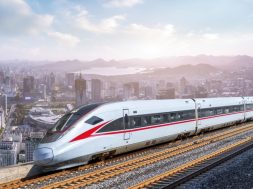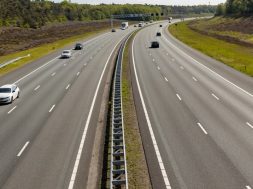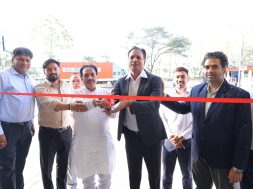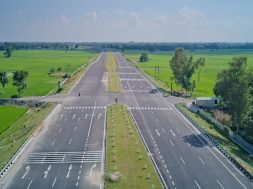JUST DIG IN! [Oct 2011]
The use of tunnels in transport sector is increasing along with the ingress of development of infrastructure. About two decades back tunnels were mainly used for hydro power generation. The ever spreading metro rail networks and construction of rail and road networks in hill states has led to construction of more and longer tunnels even in difficult geology. The design philosophy for tunnels has also developed along with the sophisticated and heavy construction machineries. It’s a big challenge for the industry to meet the present and future demand for construction works of tunnelsWhy Tunnels? The tunnels, for metro rails and city ring roads, are essential due to the space constrains in the congested city areas. In mountainous areas, the tunnels are necessary for avoiding unnecessary ascents and descents thereby reducing the route lengths between two points. Thus tunnels provide speedier way of transport. Tunnels are also constructed for flow of water from storage reservoirs for generation of hydro power. Tunnels have also been constructed for mass storage of crude.
Tunnels also help in protection of environment as otherwise open cut have to be made needing cutting of surface vegetation and causing slope failures and soil erosion.
Tunnel technologyThe tunnelling technology is an offshoot of civil engineering. Its basics lie in engineering geology, rock and soil mechanics, and construction methodology. Tunnels are classified as ‘Drill and Blast’ tunnels or ‘Bored Tunnels’. There are tunnels which are cut into the strata and covered thereafter. Such tunnels are called ‘Cut and cover’ tunnels. Metro tunnels in Kolkata were constructed using this technique.
Traditionally tunnels used to be constructed in hard rock strata. The advantages were that such strata did not need additional supports. The tunnels in Southern India mainly pass through basalt or granite and are ‘unlined tunnels’ which are easier to construct and cheaper compared to tunnels in Himalayas where costly support systems along with concrete ‘lining’ is to be provided. Tunnelling in shallow cover zones like 30 to 50m pose problems due to chances of roof collapse during construction phase. Tunnelling with very high overburden leads to squeezing and even rock bursts. Hence, an experienced tunnel engineer is necessary for every site along with an experienced geologist.
Tunnel Design Features Tunnels are traditionally designed based on empirical methods. There are different theories for design of tunnels. For all the methods of design the study of geology, hydrogeology and geomorphology is essential. Along with ‘lithology’, the ‘dip’ and ‘strike’ of the beds need to be studied. Based on these studies the engineers arrive at an index parameter and thereafter usually follow the empirical charts for further design process.
The geological strata to be encountered are classified according to the adopted design concept. The RMR classification system is generally adopted for better class of rock and ranges from 1-100 and ‘Q’ system is adopted for wider range of rock as it spreads from 0.001 to 1000. Another concept of Geological Strength Index is also being formulated by Bureau of India Standards. It will be useful for weak rocks.
Tunnels can also be designed using numerical modelling. Generally such methodology is used for design of large caverns.
The shape of tunnels is an important design feature. Circular shape is most efficient followed by elliptical or horseshoe shapes. The D-shape tunnels have been constructed for many railway projects in competent rock masses. In weak rocks D-Shape is not suitable.
Tunnel supports can be rigid or flexible. The principles of New Austrian Tunnelling Methods (NATM) and Norwegian Method of Tunnelling (NMT) are nowadays generally followed, which involve the use of rock bolts, shotcrete and lattice girders. This primary support system is followed by a rigid concrete lining. In conventional system of supports, steel ribs are used for providing the supports. In India, Bureau of Indian Standards has published ‘Tunnelling methods In Rock Masses-Guidelines’, which is a good reference.
Construction Methods The most popular method of construction of tunnels is ‘Drill and Blast’. This method involves drilling of holes for the charge. The loose rock mass generated after the blast is removed during ‘Demucking’ process. A layer of shotcrete is sprayed to seal the cracks. If need be the rock bolts are installed and thereafter the ribs are erected and concrete lagging is placed. The concrete backfilling is done behind the lagging. Need based grouting is done to fill up any gaps and also to consolidate the rock strata. The time from one cycle from blasting of charge to next blasting called as ‘cycle time’ is normally 18 to 30 hours depending on the size of tunnel, the length of tunnel and geology.
For conventional tunnel with drill and blast, the most important equipment is drill Jumbo with multiple robotic arms, the robotic shotcrete machine and other earth moving equipment. In India now these machines are becoming common and thereby the rate of progress of construction of tunnels is also increasing.
The other method is ‘mining’ of tunnels by machinery called ‘Road Header’ or by using ‘Tunnel Boring machines (TBM)’. The boring methods are costly but very efficient and fast. The boring methods can be used up to semi hard rocks.
In soil like conditions and water charged stratas, conventional ‘Drill and Blast method’ is generally adopted along with multi drifting. The approximate progress of a 50m2 cross-sectional area tunnel is about 50m per month from one side. The same by TBM can go up to 600 month! A decision regarding deployment of TBM is a serious financial decision.
Tunnel Surveys and Instrumentation It is necessary that the alignments for the tunnels are accurately controlled so that both tunnel tubes constructed from both ends meet at a common place. Nowadays use of ‘Bi-reflex’ targets and total station are being used.
Tunnel instrumentation is necessary for recording the tunnel convergence. Generally convergence up to 1 per cent of tunnel diameter is considered as non serious issue. Tunnel profile also needs to be recorded for checking deformations.Safety and VentilationsLong tunnels need rescue passages and air quality monitoring. Ventilation systems need to be provided which are operated based on the quality of air as monitored from time to time.
ConclusionTunnelling needs experienced manpower and costly machineries. Being underground work; the safety of workers, engineers and equipment need to be carefully addressed by the safety engineer. A system of tunnel muck disposal needs to be evaluated so that environment is protected.
AuthorRajesh Agarwal, IRSE, General Manager (Projects) at Konkan Railway Corp. Ltd is presently the overall in-charge of Konkan Railway’s challenging rail line project in Jammu & Kashmir. He has authored several papers that are published in many prestigious magazines. Mr. Agarwal has also delivered key notes at esteemed seminars such as International Conference on Underground Space Technology.
Cookie Consent
We use cookies to personalize your experience. By continuing to visit this website you agree to our Terms & Conditions, Privacy Policy and Cookie Policy.









